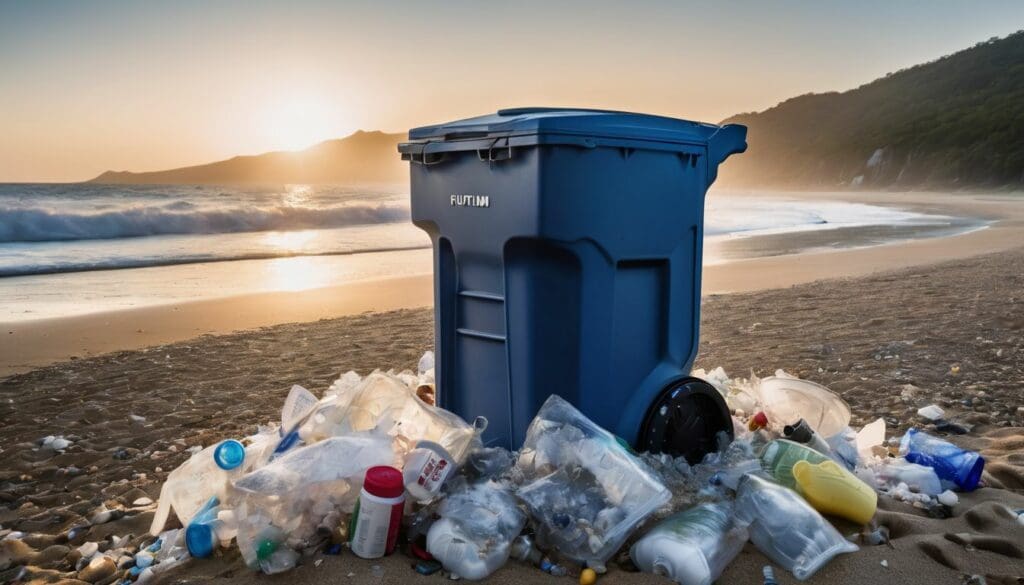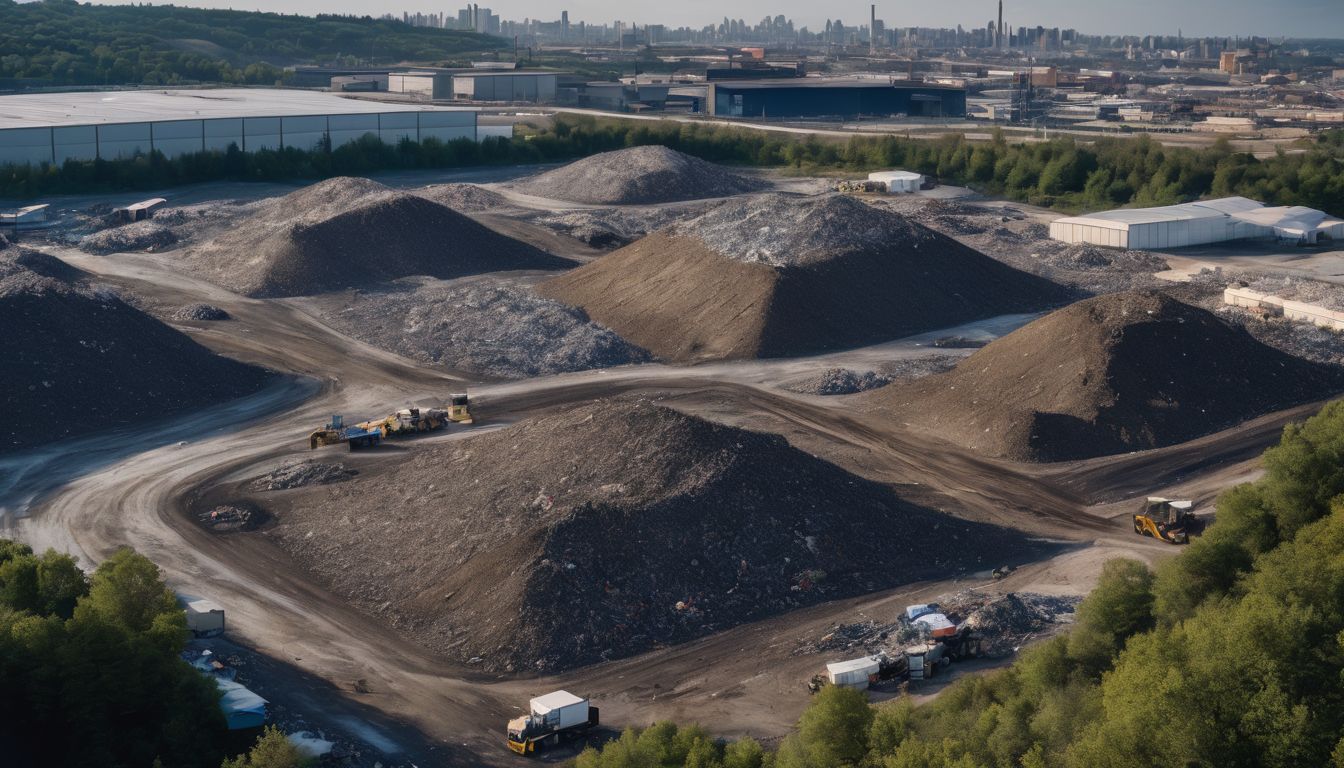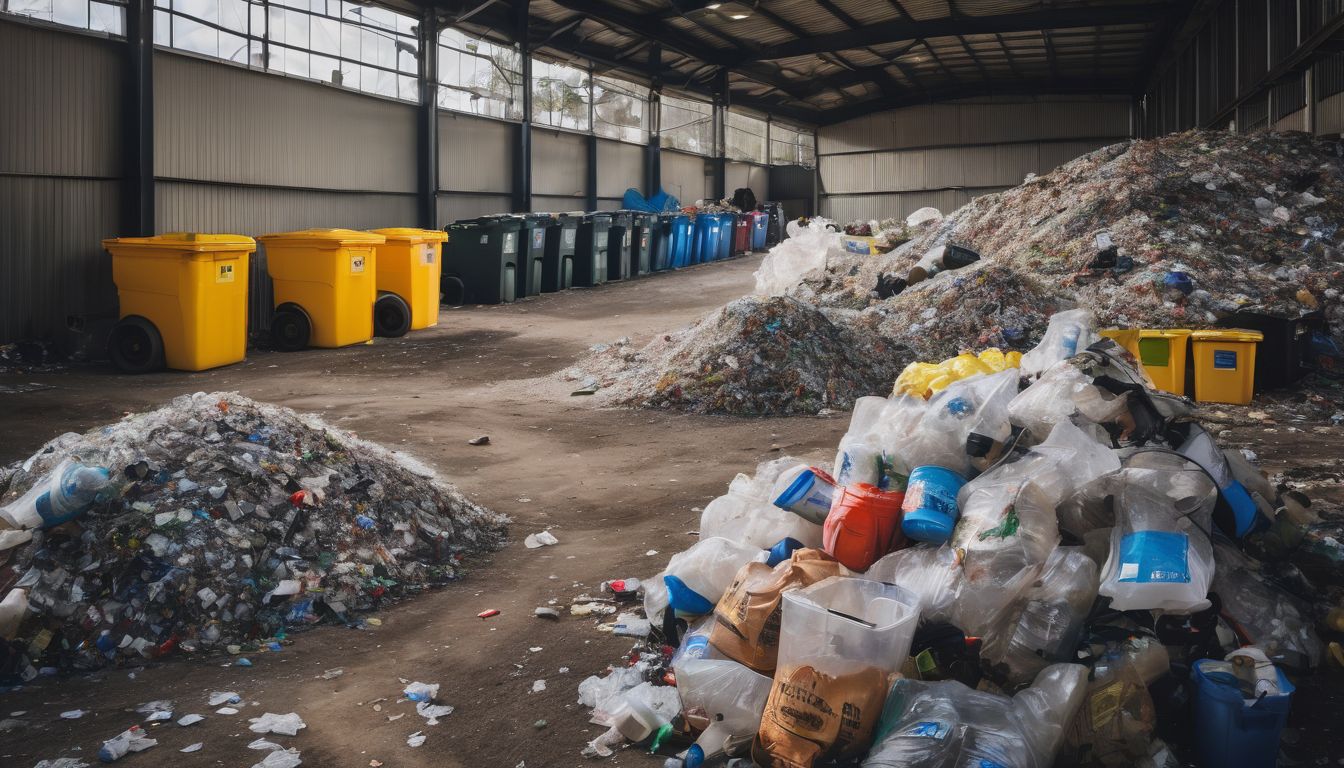Plastic wraps our sandwiches and bottles our drinks, but at what cost to the planet? Every year, millions of tonnes of single-use plastics end up in landfills and oceans. Our blog will guide you through practical strategies to cut down on this plastic tide, from personal habits to corporate responsibilities.
Stay with us – change is within reach!
Key Takeaways
- Use reusable items like water bottles, coffee cups, and shopping bags to cut down on single-use plastic waste.
- Choose products with minimal or no packaging whenever possible, such as buying fruits and vegetables loose.
- Support businesses that provide sustainable alternatives, such as refill stations for household items and eco-friendly packaging.
- Engage in community initiatives like clean-up drives and advocate for policies promoting the use of environmentally friendly materials.
- Opt for biodegradable or recyclable alternatives to common single-use plastic products like straws, cutlery, and food containers.
Understanding Single-Use Plastics
Single-use plastics are items that are designed to be used once and then thrown away, such as plastic bags, straws, and food packaging. They have a significant environmental impact, contributing to pollution and harming wildlife.
It’s important to understand the extent of their impact in order to effectively reduce their use.
Definition and examples
Single-use plastics are items intended to be used once and then tossed away. These include plastic bags, straws, coffee stirrers, soda and water bottles, and most food packaging. Our supermarkets, homes, and workplaces overflow with these products due to their cheap production costs and convenience.
Examples of single-use plastics litter everyday life: a plastic grocery bag fluttering in the wind or a straw from your morning smoothie discarded after just one slurp. Takeaway containers hastily thrown out after lunch break further add to the pile.
Each is designed for short-term use but can persist in the environment for hundreds of years.
Environmental impact
Single-use plastics have a significant negative impact on the environment, contributing to pollution and posing threats to wildlife. Plastic waste often ends up in landfills or the ocean, leading to habitat destruction and endangering marine life.
The production and disposal of single-use plastics also contribute to greenhouse gas emissions, exacerbating climate change. Additionally, plastic pollution leaches harmful chemicals into the environment, further impacting ecosystems and human health.
Reducing the environmental impact of single-use plastics requires collective efforts from individuals, corporations, and governments. By embracing sustainable alternatives such as reusable containers and eco-friendly packaging materials, we can minimise our reliance on disposable plastics.
Pollution caused by single-use plastics
Single-use plastics are a significant contributor to pollution, with items such as plastic bags, straws, and bottles often ending up in waterways and oceans. Wildlife is greatly affected by this pollution, as marine animals ingest or become entangled in plastic waste.
The presence of single-use plastics in the environment also leads to microplastic contamination, harming ecosystems and potentially finding its way into the food chain.
Creative initiatives for reducing single-use plastics involve raising awareness about their environmental impact among consumers. Consumers can then make informed choices when shopping and opt for sustainable alternatives like reusable bags, bottles, and containers.
The Call for Action
Become informed about the goals and initiatives for reducing single-use plastics, and understand the important role of governance and leadership in driving change. Look out for funding and partnering opportunities to support plastic pollution reduction efforts.
Goals and initiatives of reducing single-use plastics
To reduce single-use plastics, environmentally conscious individuals can:
- Set personal goals to cut down on plastic consumption daily.
- Commit to using sustainable alternatives to single-use plastics at home and in daily activities.
- Advocate for policies that promote the use of eco – friendly materials and packaging.
- Support businesses and organisations that are committed to reducing their plastic waste and pollution.
- Educate others about the impact of single – use plastics and encourage them to join the efforts in minimising plastic usage.
- Engage in community initiatives focused on reducing plastic waste through recycling and eco-friendly practices.
The role of governance and leadership
Governance and leadership play a crucial role in driving the reduction of single-use plastics. By implementing policies and regulations, governments can promote sustainable sourcing and recycling initiatives, thus minimising single-use plastic consumption.
Effective leadership within corporations is vital for enforcing sustainable procurement plans and partnering with commercial service providers to cut down on plastic pollution. Furthermore, these leaders can spearhead clean-up initiatives and support eco-friendly materials to decrease reliance on disposable plastics.
Through proactive governance and strong leadership, we can make significant strides in reducing the environmental impact of plastic products by promoting eco-friendly habits and alternatives to single-use plastics.
Funding and partnering opportunities
Explore funding and partnering opportunities to support conservation and environmental efforts. Seek out grants, sponsorships, or collaborations with like-minded organisations passionate about reducing single-use plastics.
Engage in sustainable procurement plans by connecting with eco-conscious suppliers and exploring bulk buying options for eco-friendly materials. By forging partnerships and accessing financial resources, individuals can take active steps towards minimising single-use plastic consumption while contributing to environmental conservation initiatives.
Consider seeking grant funding from governmental or non-governmental sources as a way of boosting your impact when it comes to cutting down on plastic pollution. Additionally, form strategic alliances with businesses that share the same vision for a plastic-free future; this collaboration could lead to innovative solutions for sustainable packaging and biodegradable alternatives, reinforcing the drive towards a zero-waste lifestyle.
Strategies for Individuals
Reduce plastic usage in daily life by using reusable water bottles, coffee cups, and shopping bags, and opt for products with minimal packaging to minimise plastic waste. To learn more about sustainable living practices, continue reading the full blog!
Reduce plastic usage in daily life
To reduce plastic usage in daily life, consider using reusable water bottles and coffee cups. Opt for products with minimal or no plastic packaging. Choose to purchase items in bulk to minimise single-use plastic waste. Bring your own shopping bags when going to the shop. Use alternative options such as metal or bamboo straws instead of single-use plastic ones. Utilise reusable containers for food storage instead of disposable plastic bags or wrap. Embrace eco-friendly alternatives like beeswax wraps for food covering. Explore sustainable personal care products that come in biodegradable or recyclable packaging. Make a conscious effort to refuse unnecessary plastic items whenever possible.
Shop sustainably
- Opt for products with minimal or no plastic packaging, such as fruits and vegetables sold loose or in paper bags.
- Choose reusable alternatives for commonly used single – use items, like bringing your own cloth bags for grocery shopping.
- Look for eco – friendly materials and products with minimal environmental impact, such as bamboo toothbrushes or stainless steel straws.
- Support businesses that prioritise sustainability by purchasing from brands with clear commitments to reducing plastic usage and promoting eco-friendly practices.
- Consider bulk buying from stores that offer refill stations for household items like soap, detergent, and cooking oil to minimise packaging waste.
Avoid plastic packaging
To reduce your use of single-use plastics, prioritise products with minimal or no plastic packaging. Opt for items wrapped in paper, cardboard, or other eco-friendly materials. Here are some practical tips:
- Choose fresh produce without plastic wrapping to cut down on packaging waste.
- Bring reusable bags when shopping to avoid using single-use plastic bags.
- Look for bulk options or refill stations for household items like detergent and soap to minimise plastic packaging.
- Support companies that use sustainable and compostable packaging materials for their products, such as biodegradable plastics or recyclable alternatives.
- Consider making your own snacks and meals instead of purchasing individually packaged items to reduce plastic waste.
Strategies for Corporations
Corporations can reduce single-use plastics by implementing sustainable procurement plans, partnering with commercial service providers, and participating in clean-up initiatives. These strategies will help to minimise plastic waste and promote a more eco-friendly business model.
Implement sustainable procurement plans
- Sourcing responsibly: Seek suppliers that offer plastic-free or minimal packaging options.
- Collaborating with suppliers: Encourage open communication and collaboration to find eco-friendly alternatives.
- Assessing product lifecycle: Evaluate the environmental impact of products from creation to disposal.
- Implementing circular economy principles: Emphasise reuse, recycling, and reducing waste throughout the product lifecycle.
- Supporting sustainable innovation: Invest in research and development for eco-friendly materials and packaging solutions.
- Engaging stakeholders: Work with partners, customers, and industry groups to promote sustainable practices.
Partner with commercial service providers
Corporations can reduce their reliance on disposable plastics by partnering with commercial service providers. By collaborating with these suppliers, businesses can access sustainable packaging, eco-friendly materials, and reusable products.
This proactive approach promotes the use of plastic-free practices and encourages a zero-waste lifestyle.
Partnering with commercial service providers allows corporations to implement plastic-free practices without compromising operational efficiency or product quality. These partnerships also support the development and adoption of alternative solutions to single-use plastics, thus contributing to the overall reduction of plastic waste in the environment.
Cleanup initiatives
Corporations sponsor coastal cleanups and participate in recycling drives to reduce plastic waste. Commercial service providers join forces with environmental organisations for beach clean-ups, removing tonnes of plastic waste from our shorelines each year.
These initiatives significantly contribute to minimising single-use plastics’ environmental impact and promoting a sustainable, eco-friendly approach.
Implementing plastic-free practices can also encompass organising community-wide clean-up events. By engaging local businesses and residents in regular street cleaning efforts, communities create environments that are more conscious of their reliance on disposable plastics.
The collective effort effectively reduces the environmental impact of plastic products and fosters a zero-waste lifestyle.
Conclusion and Further Resources
Easily implementable tips and alternative solutions have been discussed to reduce single-use plastics. For more information and resources on plastic-free living, check out the additional resources provided.
Easy tips for reducing single-use plastics
- Use reusable water bottles, coffee cups, and shopping bags to cut down on plastic waste.
- Opt for products with minimal or no packaging, such as buying fruits and vegetables loose instead of pre-packaged.
- Choose products in glass, paper, or metal packaging instead of plastic whenever possible.
- Say no to plastic straws and stirrers, and consider using alternatives made from bamboo, stainless steel, or silicone.
- Support businesses that offer refill stations for household items like cleaning products and personal care items.
- Invest in reusable food storage containers and beeswax wraps to reduce reliance on single – use plastic bags and cling film.
- Participate in or organise community clean – up events to help remove plastic litter from the environment.
Alternative solutions to single-use plastic products
Everyday alternatives to single-use plastic products include:
- Reusable bags and containers made of eco-friendly materials such as organic cotton, jute, or recycled plastics.
- Stainless steel or glass water bottles for on-the-go hydration, reducing reliance on disposable plastic bottles.
- Beeswax wraps or silicone food covers as sustainable alternatives to plastic cling film for food storage.
- Bamboo or stainless steel straws that are durable and reusable, minimising plastic straw usage.
- Compostable bioplastic cutlery and dinnerware to reduce environmental impact when disposable utensils are necessary.
Additional information and resources for a plastic-free lifestyle
Explore sustainable alternatives to single-use plastics with these resources. Access a range of eco-friendly materials and zero-waste lifestyle tips that help decrease reliance on disposable plastics.
Implementing plastic-free practices is easier with easy, actionable tips for reducing single-use plastics in daily life. Find eco-conscious solutions and habits to minimise plastic waste while supporting conservation efforts.
Discover strategies for reducing plastic usage by shopping sustainably and avoiding plastic packaging. Embrace environmentally conscious choices with alternative solutions to single-use plastic products available at your fingertips.
FAQs
1. What are some strategies to reduce single-use plastics?
Strategies for reducing single-use plastics include adopting eco-friendly alternatives, implementing plastic-free practices, and shifting towards a zero-waste lifestyle to prevent plastic waste.
2. Why is it important to minimise our use of single-use plastics?
Minimising single-use plastic helps decrease the environmental impact of these products and supports a more sustainable, eco-conscious way of living.
3. Can I live without using disposable plastics?
Yes, by choosing eco-friendly materials and developing habits that reduce plastic consumption, you can work towards a life with much less reliance on disposable plastics.
4. How do I start implementing plastic-free habits?
Begin implementing plastic-free practices by opting for sustainable alternatives to single-use items and finding new ways to be eco-friendly in your daily routine.
5. Are there any convenient alternatives to single-use plastics that I can use?
There are many convenient alternatives available including reusable bags, bottles, containers and other products made from environmentally friendly materials designed for repeated use.





